Summary
With the national focus on the Armistice Centennial, it was important for the project to ensure that Memorial Gates commemorating our local Herefordshire Regiment fallen soldiers were opened formally. The event, held on 10th November, was followed that evening with a Victory Supper, held in the Village Hall.
Graham Madeley continues to research the lives of World War 1 soldiers related to people in Eardisland – and those villages through which Memorial Walks pass. A one-page biography is produced and a copy given to the WW1 serviceman’s descendent.
Over the winter, waymarks will be checked to ensure required replacements and that directions are clear and accurate. Walkers observing and reporting defects will be especially welcome.
Situation, 3rd December 2018.
Privates Thomas Cook and John Lewis Memorial Walks were ‘opened’ along with the modest ceremony, which attends the unveiling of brass plaques on respective Memorial Gates. Three Walks remain to feature our distinctive oak kissing gates, made possible by the generosity of Hereford Community Foundation’s Pippin Trust.
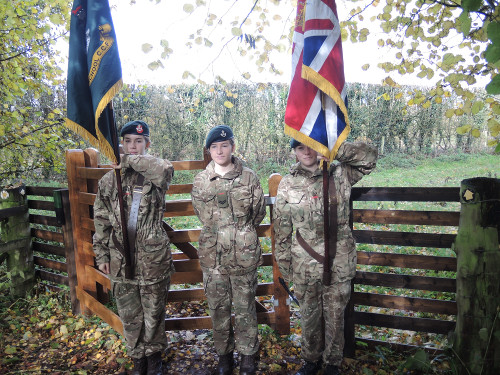
Private Thomas Cook opening – Cadets are from Lucton School and a section was included in visitors attending
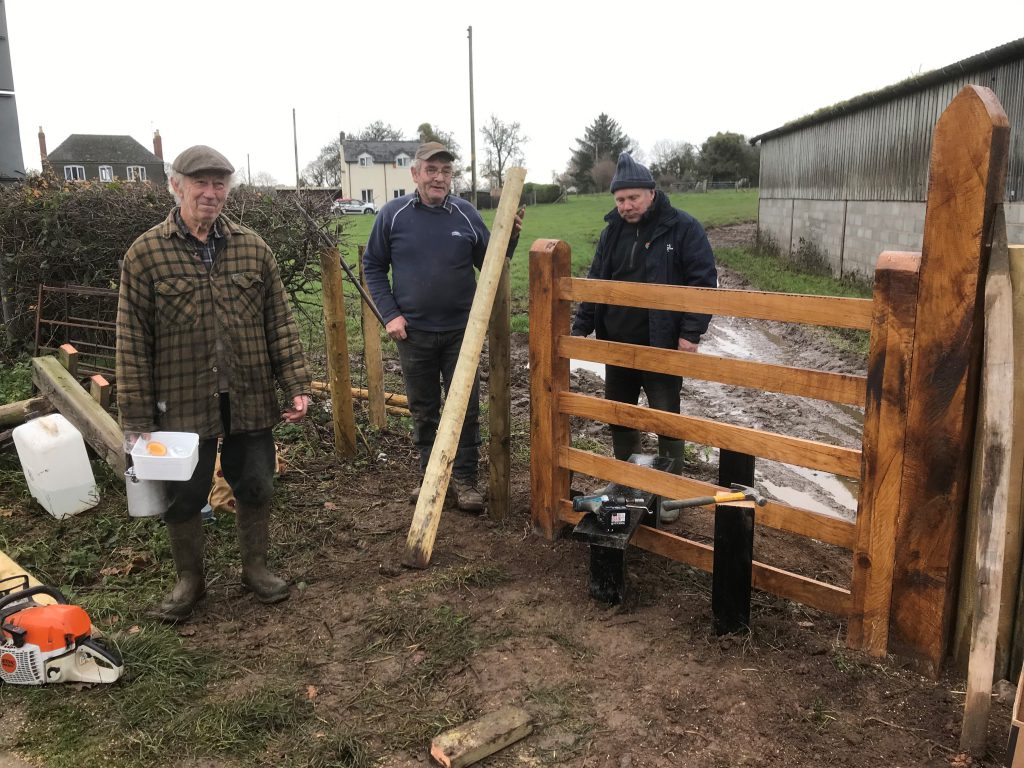
John Charles Morgan Memorial Gate under construction. Stan Blatchford, centre, is our indispensible construction specialist. Lou Davies is the supportive farmer/landowner (left) who is allowing us to erect the Memorial, and has been kind enough to provide materials as well as tea and cakes! Graham Madeley, right, is site overseer.
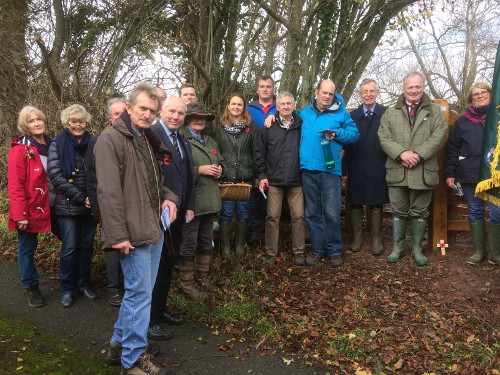
The crowd at the John Lewis Memorial Gate
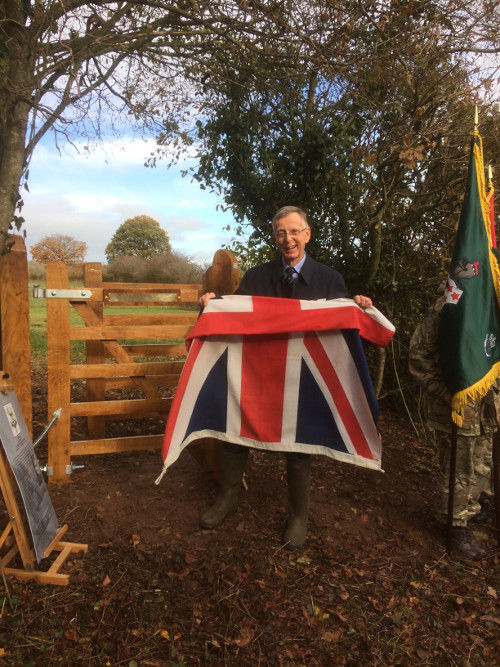
Air Vice Marshal Mike Smart opens the John Lewis Memorial Gate

Lt Col Andy Taylor, opening the Thomas Cook Memorial Gate
Guide brochures continue to be available at the Community Shop, Rita’s Tearooms and Arrowbank Caravan Park. Certain copies can be picked up from a number of pubs and cafés in surrounding villages. Over the summer, a brisk replacement effort has hopefully kept pace with demand, demonstrating a gratifying level of interest in the Walks.
Relating to the September Newsletter, Private John Charles Morgan’s Walk (No.5, 7 ½ miles) takes you up to Shirl Heath and then to Monkland and back. The new Memorial Gate is in fact a stile and is situated close to where we believe John was born. The summertime snags on this Walk, due to cropping, inadequate signing and access issues are diminished and it’s now a pleasant bash overall – with the chance to visit Monkland’s pub and cheese shop as a bonus! There is a second route: the William Webb Walk (No. 13, 10 miles), which again passes through Monkland taking a different direction. The whole area between the B4529 road from Eardisland to Leominster and the A44 between Bainstree Cross, Monkland and Leominster; part of the River Arrow’s floodplain, appears to be wholly ignored by walkers. With EMW waymarks in place, pastures cut back and arable fields clear of crops – now is a good time to explore the area!
Future intentions
A break is welcome, and in the New Year we shall we looking for ways in which to expand the project. The Memorial Gates programme will continue, otherwise the plans remain as stated in September.
Involvement
We remain grateful for help and support. E team members once again do the heavy work; Dianne Lee ensures that brochures are available.
In November, the Victory Supper proved to be a great success. This was due to the inspiration and drive of David Wallis, while Sue Wallis, Mandy Vernon and the team of amazing ladies involved in preparing, cooking and serving about 90 three-course meals simultaneously would have impressed the banqueting manager of any major 5 star hotel!
So many thanks to Wendy Priday, Diane Lee, Jo Watson, Rita Kirby, Patricia Gill, Wendy Cross, Helen Simpson, Elaine Harper, Gail Madeley and Hannah Vernon.
Phil Milchard and Graham Madeley helped set up the venue, with Alan and Martin constantly helping throughout.
Graham Madeley additionally directed and produced an extraordinarily imaginative quiz featuring aspects of the War, uncovering an equally impressive array of esoteric historical knowledge amongst the diners.
The Village Band played period music masterfully during the course of the evening, which finished with Mr Roy Wallis, the celebrated pianist, leading the New Village Choir in a hearty rendition of famous First World War songs.
Again: many thanks to all.
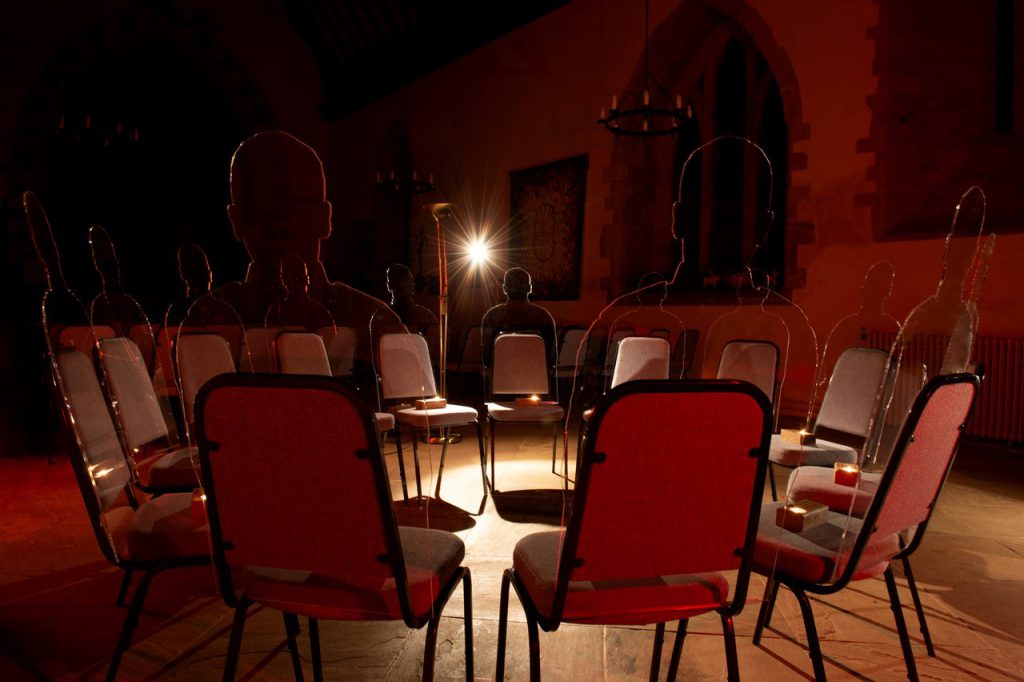
The silhouette display in St Mary’s Church, designed and photographed by Jay Watson
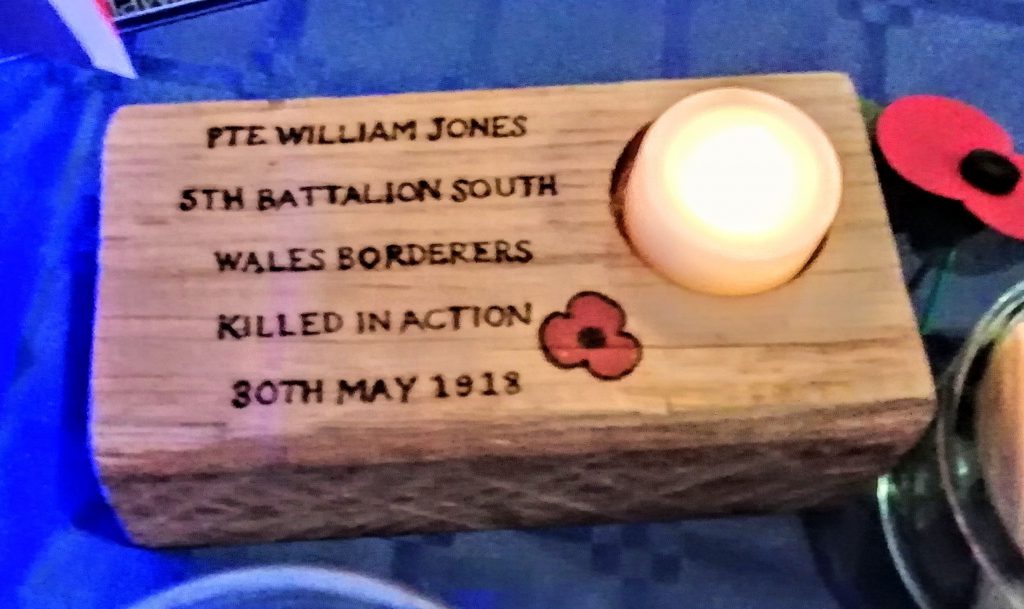
Candleholder for Armistice Day, hand made by the Administrator at Choices Foundation. One was made for each of our Fallen, and used in St Mary the Virgin Church.
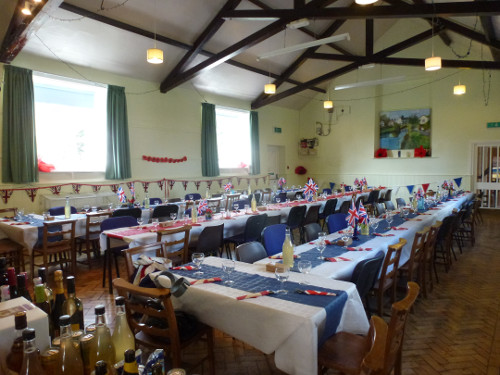
The Village Hall, ready for action!
Poets’ corner
Here are two WW1 related poems. Thanks to Pat and Allan Newcombe for The Village Memorial, sent by her cousin.
The Village Memorial
Set into stone, their names carved crudely,
No one passing could help but see
Thomas Eden, William Bewdley, James Llewellyn and young Ted Lee.
Nothing has changed, the hens go scratting
Round the humps of the village green;
There in the sun sits an old man plaiting
Hurdles of alder with grass between.
Teazles are drying and cocks are crowing,
People are calling “M’dear, m’dear!
Freely and fine the gossip’s flowing –
But Thomas Eden’s not there to hear.
Nothing is altered, rooks still quarrel,
High in the elms over Bewdley’s loft,
Still the meadows are plagued with sorrel,
Still the clover springs green and soft.
Evening passes with gentle fingers,
Starshine falls on the sycamore tree
And under the leaves, the moth-light lingers –
But William Bewdley’s not there to see.
So little alters, girls are kindly
And boys are feverish, bold and mad.
Eyes still worship and hearts leap blindly
And none but the old are stern and sad.
Feet stir blithely above the grasses,
Laughter, out of the heart’s rich store,
Lightly quivers and lightly passes –
But James Llewellyn will laugh no more.
Nothing has changed, the hens are scratting
Round the stumps on the tawny green.
Farmer Ingleby’s Matthew’s batting,
Landlord, Ernie, has made 15.
The lads are laughing, the girls are prinking
All’s the same as it used to be –
Yet I couldn’t play there and not be thinking
“No more cricket for young Ted Lee”.
Here where life runs lustily, crudely,
This were heartbreak to stand and see
Snatched forever to silence – Bewdley,
Eden, Llewellyn and young Ted Lee.
The second is a poem perhaps written from a trench position somewhere on the Western Front. The original, handwritten document, is held by Alex and Peter Atkinson. Graham Madeley researched the writer: E.L Pharzyn was an officer in the 1st Norfolks Regiment.
An initiation to the New Armies
Ypres Winter 1914-15
By E.L. Pharogyne
(After “If” – with apologies to Rudyard Kipling.)
If you can find your way to scattered trenches,
Lost in the inky darkness of the night,
And now fall into the mud which quenches,
All that is left of ardour for the fight.
If you can wade and never tire of wading
Knee deep to another mile of clammy ooze,
If you can stand constant serenading
Of German shells and not give way to booze.
If you can leave for days inside your funk-hole
And sing eternally of Leicester Square
And live the cramped life of a poor old dead mule
With all the patience of a Flanders mare.
If you can make a meal of plum and apple
And wash it quickly down with well-stewed tea
If you can force in your mouth and brain to grapple
With mud stained doles of called MACONOCHIE.
If you can spend your night in mainly digging,
More useless trenches for the rain to fill
And then return to find your best friend swigging
Your craved for long’d for, one and only Jill.
If you can be polite when Minnie crashes
Among your sand-bags at the break of day
Or smile to watch a whiz-bang as it smashes
The work of many hours in spiteful play.
If it amuses you to fight the Boches,
If you delight in the rain and blood and clay
if you can love the ‘Staff’ in their galoshes
And watch your best friends taken day by day.
If you are keen to try a fall with glory
And count the horrors lost in victory one
No matter if you’re Socialist or Tory
you hurry up and take my place my son.